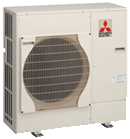Above are the two arrays of nine Schuco panels on the roof. They are supported by a heavily-galvanised robust steel rail system and connected electrically in series so as to generate anything up to 600 volts DC on a good sunny day. The output power is connected to a massive box, the inverter (see below).
The inverter and its associated safety switches mounted on the board below it, is really the 'brains' of the system, transforming a variable DC input into AC at the voltage and frequency required to feed it into the National Grid or to power appliances in the house. The small white box on the upper right of the board below the inverter records exactly how many kilowatt-hours of power are generated. Our electricity supply company Ecotricity needs to know the total in order to pay us for the power we have generated. With the new feed-in tariffs, this amounts to 41.3 pence per kilowatt-hour. The power is pumped into the Grid via an armoured underground cable which connects to the meter box of Gwyndy, our holiday cottage, which will now be rendered carbon-negative and so can be truly claimed (as we do!) to be an eco-cottage.
Above is one of the simple but rather clever displays on the inverter which tells us how much power is being generated. You can move backwards from Today to Yesterday to the Week or Month and see all the aggregated totals. These include the amount of money generated - always good to know! - and the number of kilograms of CO2 saved by this particular solar powered installation; the feel-good factor.
Are we now carbon-neutral? I don't know but we've
- insulated everything we can in Gwyndy and Mur Crusto farmhouse
- have one economical car
- installed wood-burning stoves for both buildings with all wood sourced from the farm
- built a solar heat collecting conservatory
- installed an energy-saving air source heat pump
- installed the PV system I've described in this post
System details
- maximum power the system can generate under ideal conditions - 3.78kWpeak
- expected generation per year - 2900kW
- saving in CO2 over 1 year - 1.6 tonnes
- system is based on 18 Schuco MPE 215 PS 05 polycrystalline, photovoltaic panels
mounted on the south facing roof of the barn - the solar panels are covered by a 25 year manufacturer’s performance guarantee
- total cost - 16,550 GB pounds
- return on invested capital - 8.7 percent in first year rising incrementally to 15 percent in 25 years. Unlike the stock market, this investment payback is guaranteed and in any case generates far more than money held in a bank savings account
- payback time about 10 years
- annual income from sale of power generated - about 1,500 GB pounds
